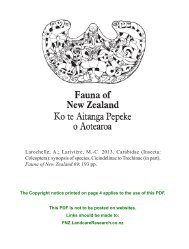Field Guide. cropping and pastoral grazing on flat to rolling country.
Field Guide. cropping and pastoral grazing on flat to rolling country.
Field Guide. cropping and pastoral grazing on flat to rolling country.
Create successful ePaper yourself
Turn your PDF publications into a flip-book with our unique Google optimized e-Paper software.
SOIL INDICATORSEarthworm counts under <str<strong>on</strong>g>cropping</str<strong>on</strong>g> Sort carefully through the soil sample used <strong>to</strong> assess soil structure,<str<strong>on</strong>g>and</str<strong>on</strong>g> count the earthworms found in a 5 minute search. Earthwormsvary in size <str<strong>on</strong>g>and</str<strong>on</strong>g> number depending <strong>on</strong> the seas<strong>on</strong>, so for year-<strong>to</strong>-yearcomparis<strong>on</strong> earthworm counts must be made at the same time ofyear, <str<strong>on</strong>g>and</str<strong>on</strong>g> preferably during the winter. The class limits for earthwormnumbers given opposite are based <strong>on</strong> the probability that you willfind <strong>on</strong>ly two-thirds of the worms present during a 5-minute search.(Earthworm numbers are comm<strong>on</strong>ly reported <strong>on</strong> a square-metre basis.A 20 cm cube sample is equivalent <strong>to</strong> 1/25 square metre <str<strong>on</strong>g>and</str<strong>on</strong>g> so thenumber of earthworms counted should be multiplied by 25 <strong>to</strong> c<strong>on</strong>vert<strong>to</strong> a square-metre basis. If your sample depth is <strong>on</strong>ly 0-10cm, thesame class limits <str<strong>on</strong>g>and</str<strong>on</strong>g> c<strong>on</strong>versi<strong>on</strong> fac<strong>to</strong>rs apply, because comm<strong>on</strong>earthworms are most abundant in the upper <strong>to</strong>psoil.)EARTHWORMS PLAY A MAJOR ROLE, through their burrowing, feeding<str<strong>on</strong>g>and</str<strong>on</strong>g> casting, in decomposing <str<strong>on</strong>g>and</str<strong>on</strong>g> cycling organic matter, <str<strong>on</strong>g>and</str<strong>on</strong>g> in supplyingnutrients. They can also improve soil porosity <str<strong>on</strong>g>and</str<strong>on</strong>g> aerati<strong>on</strong>, waterinfiltrati<strong>on</strong> <str<strong>on</strong>g>and</str<strong>on</strong>g> c<strong>on</strong>ductivity, aggregate size <str<strong>on</strong>g>and</str<strong>on</strong>g> stability, reduce surfacecrusting, <str<strong>on</strong>g>and</str<strong>on</strong>g> increase root growth <str<strong>on</strong>g>and</str<strong>on</strong>g> subsequent grain yield.24 VISUAL SOIL ASSESSMENT: Volume 1
















